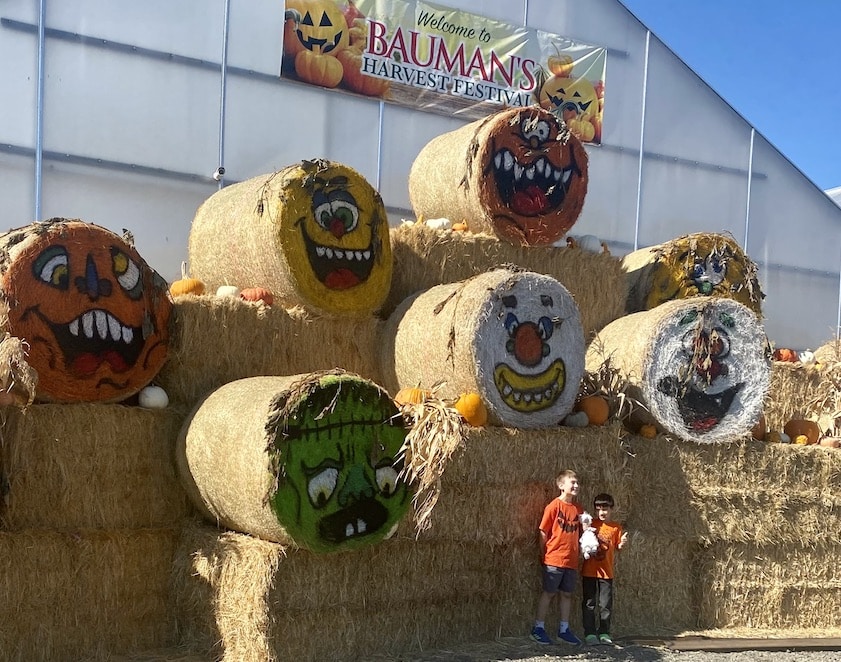
Excitement, good food and fresh air. All exist in abundance at the Bauman’s Harvest Festival in Gervais, Oregon. Photo by Teresa Bergen
By Teresa Bergen
It’s the first Saturday in October at Bauman’s Harvest Festival in Gervais, Oregon and dozens of children with their parents are running for the petting zoo. Petting zoos are probably the most popular attractions at autumn harvest celebrations now occurring across the U.S. and Canada. The baby goats are totally adorable and surprisingly gentle as they nibble pieces of straw right from children’s hands. The geese are more standoffish. The animals like the attention. And the kids don’t seem to mind the ripe barnyard smell.
On the other side of a tent selling hot coffee, apple tarts and pumpkin scones more parents and kids are scrambling up a hay bale pyramid or crowding expectantly around an above ground pool to watch enormous pumpkins grown by local farmers meet a cruel fate. An emcee addresses the families over a loudspeaker, telling the crowd how the pumpkins grew 50 to 60 pounds a day right up to the moment they were harvested. “Today is when farmers say goodbye to their babies,” he says sympathetically to attendees jostling for unobstructed positions. And now some of the biggest pumpkins will be sacrificed.
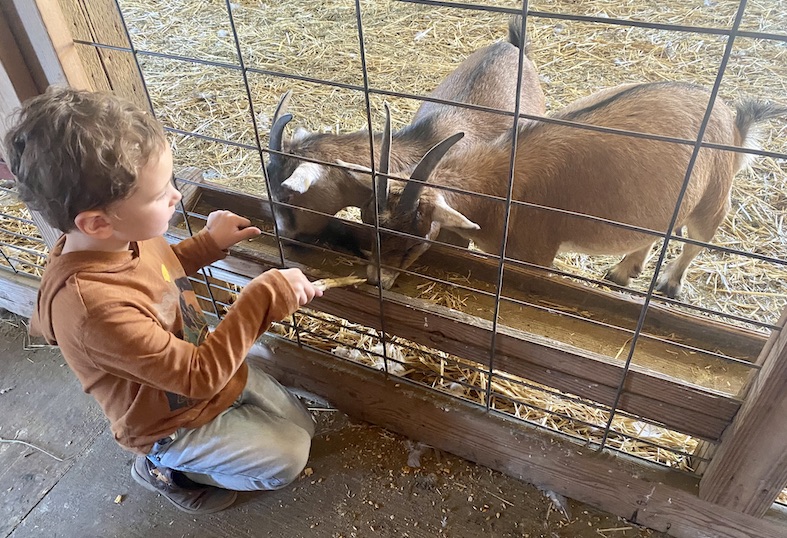
Petting zoos that allow young children to meet young animals are popular attractions at family-oriented harvest festivals. Photo by Teresa Bergen
“Higher! Higher! Higher!” The exhortations grow louder as a specially outfitted crane slowly lifts a 1,125-pound pumpkin high into the air. When the pumpkin at least reaches an elevation of 100-ft. the crane stops and the crowd waiting below starts counting down from ten. Moments later, the crane releases the pumpkin which plummets into the pool, sending an eruption of water and pumpkin chunks raining down on the screaming crowd. Beside me, eight-year-old Zachary watches wide-eyed. He’s been to the harvest fest three or four times before, his father confides, but this is his first pumpkin drop. Judging by Zachary’s jubilant reaction to the first pumpkin’s demise, he will insist on returning next year.
Competing With the Metaverse
Harvest festivals work hard these days to vie for kids’ attention with video screens. Bauman’s goes all out with its annual pumpkin drop. Even the teenagers put down their phones long enough to fire apple cannons, crawl through the Gopher Holes – big pipes transecting a dirt hill — and find their way through multiple mazes, made of sheaves of corn or bales of hay.
Instead of the razzle dazzle of cannons and exploding pumpkins, the Swiss Historical Village Harvest Fest in New Glarus, Wisconsin attempts to transport festival goers back in time. “Our festival gives visitors a peek into what life may have been like for 19th century Wisconsin settlers,” said Bekah Stauffacher, executive director of the New Glarus Chamber of Commerce. “Local experts give live, hands-on demonstrations on cheesemaking, blacksmithing, spinning, weaving, rope twisting, beekeeping, and lots more. It’s a real eye-opener, especially for kids!”
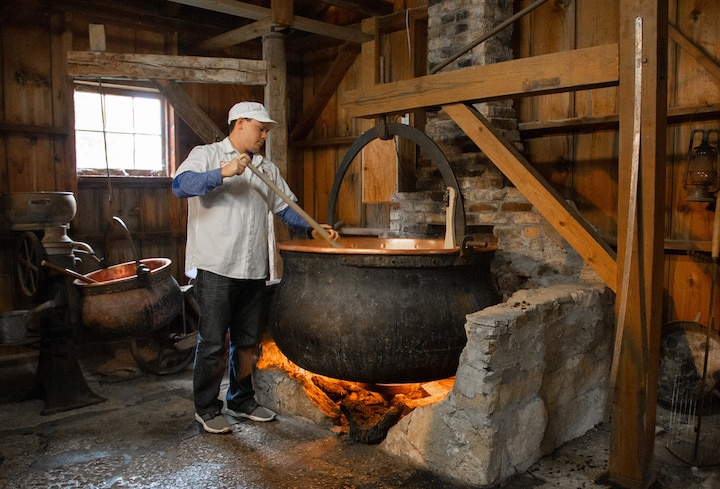
The Swiss Historical Village Harvest Fest in New Glarus gives residents and visitors a feel for what life was like when settlers from Germany and other places in Europe moved to Wisconsin. Photo courtesy of New Glarus Chamber of Commerce.
Traditional harvest fest activities
Every fair has its own activities to hook visitors. At the North Carolina Pecan Harvest Festival in Whiteville, automobile enthusiasts pack the annual car and truck show to see which of their vintage Fords and Chevrolets wins the prize of best restoration. The International Rice Festival in Crowley, Louisiana, has all the age groups covered, from a children’s parade to a senior citizen’s ball. It showcases regional flair with a fiddle and accordion contest, performances from bands like Grits & Gravy, and a rice and creole cookery contest presided over by the reigning Rice Festival queen.
Favorite harvest fest foods
Food is one of the biggest harvest festival draws for people living in rural communities and the periphery of large cities. People might devour dishes and quantities that they wouldn’t usually eat. The Oktoberfest Zinzinnati in Cincinnati, Ohio, features the World Brat Eating Championship. Non-competitors can also gorge on German foods like sauerkraut, pretzels, pickled pigs’ feet, cream puffs and potato pancakes. At Fall for Greenville in South Carolina, fair foods are typically Southern, such as fried green tomatoes and shrimp and grit cakes. In Maine, they have a whole different type of crop. The Harvest on the Harbor in Portland, Maine features oysters.
An Apple a Day
Apples were a vital crop for early North American pioneers. Apples were cooked down into apple butter and pressed into cider. Because drinking water often was contaminated, cider became the beverage of choice.
In Pacific Northwest states like Washington and Oregon, it’s all about apples. People crowd around machinery for an apple press demo, followed by fresh cider samples. In Oregon, a large farm easily can crush 560,000 pounds of apples to make 40,000 gallons of apple cider. Throughout the month of October and well into November harvest fests turn the cider into delicious apple cider slushies that everyone seems to enjoy between pumpkin lattes.
In New York, Wayne County is hosting its twenty-fifth annual County Apple Tasting Tour. “Even with weather challenges, like the drought at the beginning of this season, we rally together to support local farms and to celebrate the harvest that is so important to Wayne County,” said Christine Worth, the director of tourism for Wayne County and organizer of the Apple Tasting Tour.
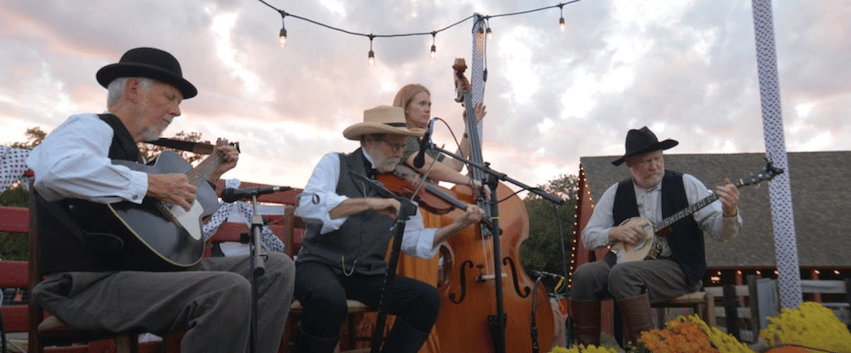
Music is as big a part of harvest celebrations as apples, pumpkins and corn. These local musicians play in Texas, but they would be welcome anywhere people gather to celebrate the end of a successful growing season. Photo by localprofile.com
First held in 1888, Johnny Appleseed Days in Paradise Ridge, CA is one of the oldest harvest festivals on the Pacific Coast. The October event celebrates the region’s orchard heritage with apple pie and ice cream, as well as apple pie kits with fresh apples, a limited-edition commemorative tea towel, and a “super-secret” Paradise Apple Pie Spice Mix. Don’t miss savoring a slice in the Pie Pavilion
Throughout the U.S., crops are being harvested and animals corralled after a summer of grazing in the hills. Farmers are bringing their prize-winning animals and hauls of apples, corn and pumpkins to festivals. City people and country folks mix as they indulge in eating apple pie and trying to escape corn mazes The sweet smell of caramel corn and the sounds of old standards like “La Bamba” fill the air. Everybody is out to have fun.
But 2022 has been a challenging year for farmers whose livelihood comes from the land. Since 2019, much of the world has suffered from drought. At the start of October, half of the continental U.S. suffered from drought conditions. If many farmers’ smiles seem forced this fall it’s because their fields yielded diminished amounts of tomatoes, corn, wheat and other agricultural products.
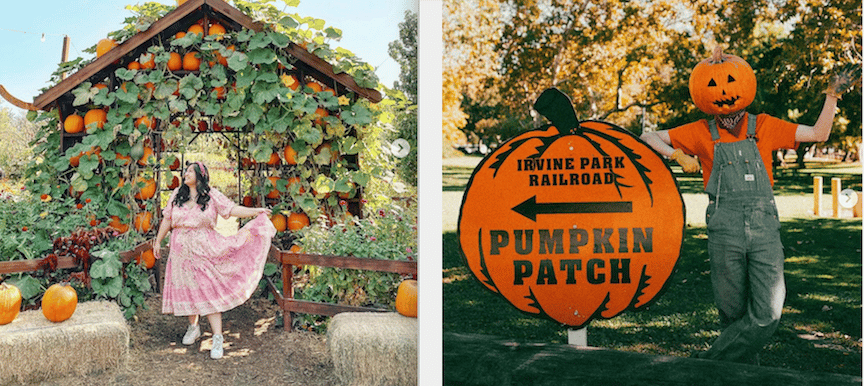
In dry Texas, ranchers have been selling off their herds because there’s not enough water for cattle to drink or to keep the grass green for grazing. The small city of West had to cancel its sunflower festival recently because of the drought. The only way to salvage the pumpkin festival was to buy pumpkins from a third party. “What we spent on one tractor trailer load, we grew over 25 acres last year, which would have filled that same tractor trailer at least 15 times,” Taylor Huffman, co-owner of Western Belle Farm, told a local TV station. “It is significantly more expensive when we have to purchase our pumpkins.”
In New England autumn normally brings cooling showers. But this year intermittent rain is insufficient to make up for months of dry weather. “Because of the drought, apples were really small early on,” says Gary Wells, owner of The Apple Shed & Maple Ridge Fruit Farm of Wayne County, New York. “Late rains allowed some of the apples to size up, but most of the crop is smaller than normal.”
Drought and wildfires have affected different parts of the US more than others. But communities are pulling together to reenact harvest traditions in celebrations that last through mid-November.
Harvest Festivals Go Global
Autumn harvests across America have consequences that reverberate around the world. According to the U.S. Agency for International Development, more than 800 million people go to bed hungry every night. Because of its bounty, the U.S. is the top donor to the World Food Program. Indeed, since the 1950s, America routinely contributes about half of the total food donations.
This year, the U.S. has sent hundreds of tons of sorghum, vegetable oil and yellow split peas to hungry African nations suffering through a food crisis. Texas and North Dakota are top producers of sorghum, a grain that travels better than wheat. All over the U.S. farmers are heroes to their neighbors, a fact that rarely makes the nightly news.
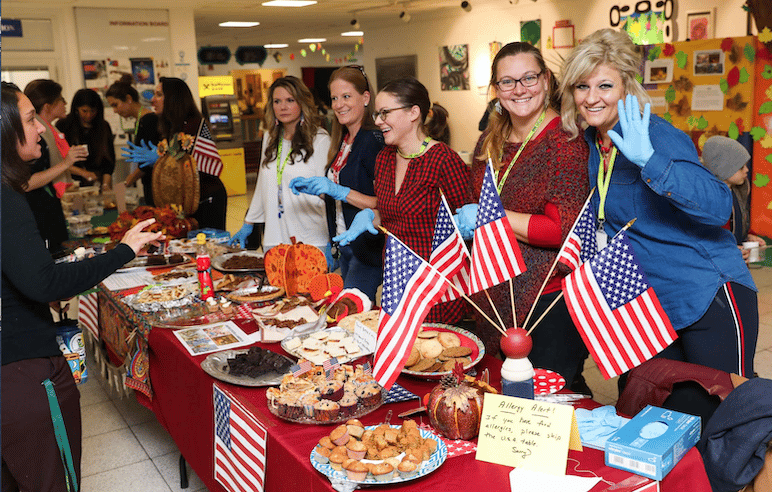
American International School of Bucharest, Romania
Harvest celebrations are not native to North America. The November ritual Americans call Thanksgiving dates from 1621. It was brought across the Atlantic by Protestant Pilgrims from England and the Netherlands. The Mid-Autumn Festival, also known as the Moon Festival, is one of the most widely spread harvest festivals in the world. It began in Mainland China and today is celebrated in every country where Overseas Chinese reside. An old Zoroastrian festival called Mehregan marks harvest time in Iran. In Kerala, India, a late summer and autumn gathering called Onam celebrates the rice harvest.
Societies around the globe enjoy cultural events throughout the year, but few are as essential as harvest fests which celebrate natural bounty, hard work and the willingness to share with others.![]()
East-West News Service contributor Teresa Bergen lives in Portland, OR and loves to see gigantic pumpkins splatter. Her previous stories include a look at digital nomads in Idaho and life above the Arctic Circle in Alaska.

